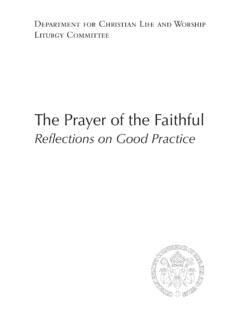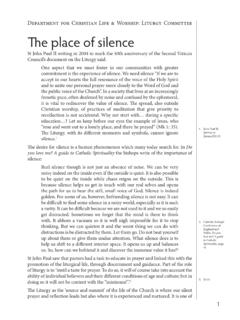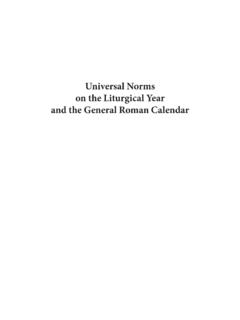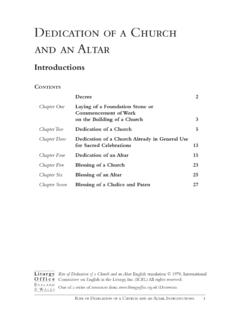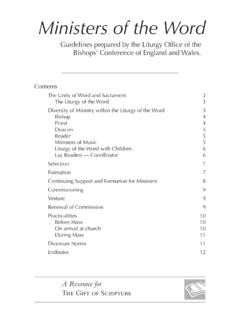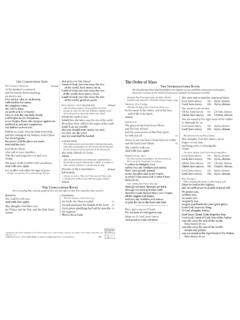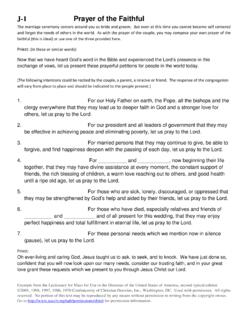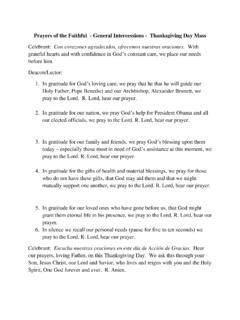Transcription of The Prayer of the Faithful - Liturgy Office
1 General Instruction of the Roman Missal69. In the Prayer of the Faithful , the people respond in a cer-tain way to the word of God which they have welcomed in faith and, exercising the Office of their baptismal priest-hood, offer prayers to God for the salvation of all. It is fitting that such a Prayer be included, as a rule, in Masses celebrated with a congregation, so that petitions will be offered for the holy Church, for civil authorities, for those weighed down by various needs, for all men and women, and for the salvation of the whole world. 70. As a rule, the series of intentions is to be: a. for the needs of the Church; b. for public authorities and the salvation of the whole world; c.
2 For those burdened by any kind of difficulty; d. for the local community. Nevertheless, in a particular celebration, such as Confir-mation, Marriage, or a Funeral, the series of intentions may reflect more closely the particular occasion. 71. It is for the priest celebrant to direct this Prayer from the chair. He himself begins it with a brief introduction, by which he invites the Faithful to pray, and likewise he con-cludes it with a Prayer . The intentions announced should be sober, be composed freely but prudently, and be suc-cinct, and they should express the Prayer of the entire community. The intentions are announced from the ambo or from an-other suitable place, by the deacon or by a cantor, a lector, or one of the lay Faithful .
3 The people, however, stand and give expression to their Prayer either by an invocation said together after each in-tention or by praying in silence. Celebrating the Mass171. Enlightened and moved by God s word, the assembly exer-cises its priestly function by interceding for all humanity. Because the joy and hope, the struggle and anguish of the people of this age and especially of the poor and those suffer-ing in any way are the joy and hope, the struggle and anguish of Christ s disciples, the Church prays not just for its own needs but for the salvation of the world, for civil authorities, for those oppressed by any burden, and for the local com-munity, particularly those who are sick or who have died.
4 172. Thus, even though the intercessions may be quite con-crete or particular in content, they should always look beyond the concerns of the local assembly to the needs of the whole Church and of the wider world. They are a sign of the communion of the particular assembly with all other assemblies and with the universal The priest celebrant directs the Prayer from the chair. He briefly invites the people to pray, and at the end he draws their intercessions together in a brief concluding Prayer with a short doxology. The intentions are proposed by a deacon, a cantor, reader, other minister, or members of the assembly at the ambo or another suitable place.
5 Af-ter each intention, the Faithful respond by silent Prayer or a common response or both. They affirm the concluding Prayer of the priest with their Amen. It is appropriate for the Prayer of the Faithful to be in-cluded in all Masses. Both the priest s introduction and the proposed inten-tions are addressed to the assembly, not to God. They are invitations or biddings to the Faithful , who normal-ly will first pray silently for each intention and then give expression to their common Prayer in an invoca-tion sung or said together after each intention. Alter-natively the Prayer after each intention may simply be offered in silence. These intentions should be short, clear, and objective enough for the Faithful to understand and respond to them without difficulty.
6 They should express the Prayer of the entire community. There should be a significant pause after the intention has been read, while the as-sembly prays before the response is sung or said The response they are to evoke is petition rather than praise, thanksgiving, or repentance. On particular occasions, when other Sacraments or particular rites are celebrated in conjunction with the Mass, the range of intentions may be more closely concerned with the occasion; but even so, the interces-sions should always include some general or universal intentions. For each intention, the invitation to pray and the re-sponse may be sung or the entire intention may be sung or even spoken while music is played.
7 The Roman Rite does not envisage the inclusion of de-votional prayers in the Prayer of the Faithful . As is tra-ditional with liturgical Prayer , the Prayer of the Faithful is addressed to the Father, through the Son and in the Spirit. Those who read the intentions return to their place only after the completion of the concluding Prayer . Sample formulas for the Prayer of the Faithful are giv-en in Appendix III of the Roman Missal. The Prayer of the Faithful How to use this worksheetOn the outside pages general information is provided on the Prayer of the the inner pages space is provided to draw up the text of the Intentions. Space is given in the left-hand column to note areas of need and concern in the Church and the World that it is desirable to pray for.
8 In the right-hand column there is space to note phrases and images from the given Liturgy of the Word that might be helpful when preparing the from General Instruction of the Roman Missal 2005 In-ternational Commission on English in the Liturgy , resource is one of number of re-sources to help parish communities pre-pare and celebrate the Liturgy worthily. 2008 Catholic Bishops Conference of England and Wales. Liturgy Office , 39 Eccleston Square, London SW1V 1PL t u r gyOf f i ceEN G L A N D& WA L E SWhat needs to be prayed for? Phrases and images from the Readings?in the life of the Church:First Readingin the world:Responsorial Psalmthose in need:Second Reading in the local community:GospelPrayer of the FaithfulDay _____Date _____Introduction _____ _____ _____1.
9 _____ _____Response: Lord, in your mercy. Hear our Prayer or Lord, hear us. Lord, graciously hear us. or _____2. _____ _____3. _____ _____4. _____ _____5. _____ _____6. _____ _____Concluding Prayer _____ _____ _____ _____ _____ _____Advent/ChristmAsOpenness to the Word of Godespecially on Bible Sunday (Second Sunday in Advent)Migrants and Refugeesespecially on Migrants Day (3 December)Expectant Mothersespecially on Fourth Sunday in AdventOrdinAry time: WinterPeace On Earthespecially on the Day of Prayer for Peace (2nd Sunday in Ordinary Time) and on Racial Justice Day (3rd Sunday before Lent)Christian Unityespecially during the Octave of Prayer for Chris-tian Unity (18 25 January)The Sick and Those Who Care forThemespecially on the World Day for the Sick (11 February)Victims of Human Traffickingespecially on feast of St Josephine Bakhita (8 Feb-ruary)The Unemployedespecially on the Sunday before the First Sunday of LentLentCandidates for the Sacramentsespecially on the Sundays of LentWomen s World Day of Prayer (first Friday in March)The Needy and Hungry of the Worldespecially on Family Fast Day (Friday of the first week in Lent)
10 Survivors of Sexual Abuse(Friday of the fifth week of Lent)Penitents and WandererseAsterNew Members of the ChurchVocationsespecially on the World Day of Prayer for Voca-tions (Fourth Sunday of Easter)Human Workespecially on St Joseph the Worker (1 May)The Right Use of the Mediaespecially on World Communications Day (Seventh Sunday of Easter)The Churchespecially PentecostOrdinAry time: summerA Deeper Understanding between Christians and JewsThose Who Suffer Persecution, Oppression and Denial of Human Rightsespecially on St John Fisher and St Thomas More (22 June)Europeespecially on the Feast of St Benedict who, with St Cyril and St Methodius (14 February), is patron of Europe (11 July )Human Lifeespecially on 3rd Sunday in JuneSeafarersespecially in Sea Sunday (2nd Sunday in July)OrdinAry time.
